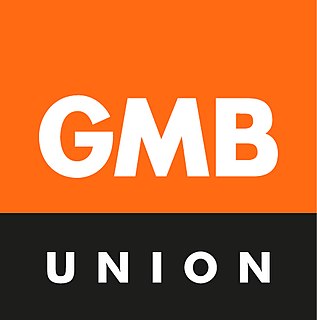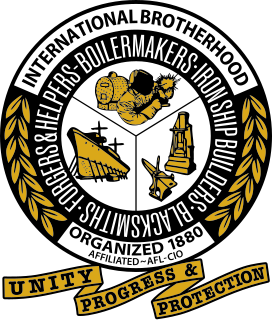Related Research Articles

The GMB is a general trade union in the United Kingdom which has more than 631,000 members. Its members work in nearly all industrial sectors, in retail, security, schools, distribution, the utilities, social care, the National Health Service (NHS), ambulance service and local government.

The Transport and General Workers' Union was one of the largest general trade unions in the United Kingdom and Ireland – where it was known as the Amalgamated Transport and General Workers' Union (ATGWU) to differentiate itself from the Irish Transport and General Workers' Union – with 900,000 members. It was founded in 1922 and Ernest Bevin served as its first general secretary.
The Dock, Wharf, Riverside and General Labourers Union (DWRGLU), often known as the Dockers' Union, was a British trade union representing dock workers in the United Kingdom.

The International Brotherhood of Boilermakers, Iron Ship Builders, Blacksmiths, Forgers and Helpers (IBB) is a trade union in the United States and Canada. It is for boilermakers and related occupations, and is affiliated with both the AFL-CIO and CLC.

The Irish Transport and General Workers Union (ITGWU), was a trade union representing workers, initially mainly labourers, in Ireland.

The Union of Construction, Allied Trades and Technicians (UCATT) was a British and Irish trade union, operating in the construction industry. It was founded in 1971, and merged into Unite on 1 January 2017.
The United Order of General Labourers was a trade union representing labourers, mostly in the construction industry, in the United Kingdom.
The Public Works and Constructional Operatives' Union was a trade union representing labourers in the United Kingdom.
The National Union of General Workers (NUGW) was an early general union in the United Kingdom, the most important general union of its era.
The National Amalgamated Union of Labour (NAUL) was a general union in the United Kingdom.

The Confederation of Shipbuilding and Engineering Unions (CSEU), often known as the Confed is a trade union confederation in the United Kingdom.
The Amalgamated Society of Engineers (ASE) was a major British trade union, representing factory workers and mechanics.
The London builders' strike of 1859 was a strike and resulting lock out of building trade workers across London. The action did not result in any changes to working conditions, but it led to the formation of new, national trade unions in the United Kingdom.
The General Union of Loom Overlookers (GULO) was a trade union representing junior supervisors in textile manufacturing in the United Kingdom. While most members were based in Lancashire, it also had members in Yorkshire, East Anglia and Essex.
The National Federation of Building Trades Operatives (NFBTO) was a trade union federation in the United Kingdom, consisting of unions with members in construction and related industries.
The United Builders' Labourers Union was a trade union representing labourers in the construction industry in the United Kingdom.
The Amalgamated Society of Gas Workers, Brickmakers and General Labourers (ASGWBM&GL) was a trade union representing labourers in the United Kingdom, particularly in the Birmingham area.
W. Richard Davies was a Welsh trade unionist and political activist. The president of one union, and general secretary of another, he also served as a city councillor and contested numerous Parliamentary elections.
References
- 1 2 Arthur Marsh and Victoria Ryan, Historical Directory of British Trade Unions, vol.3, p.123
- ↑ Waddington, Jeremy (1995). The politics of bargaining: the merger process and British trade union structural development, 1892-1987. Routledge. p. 82. ISBN 0-7201-2245-7.